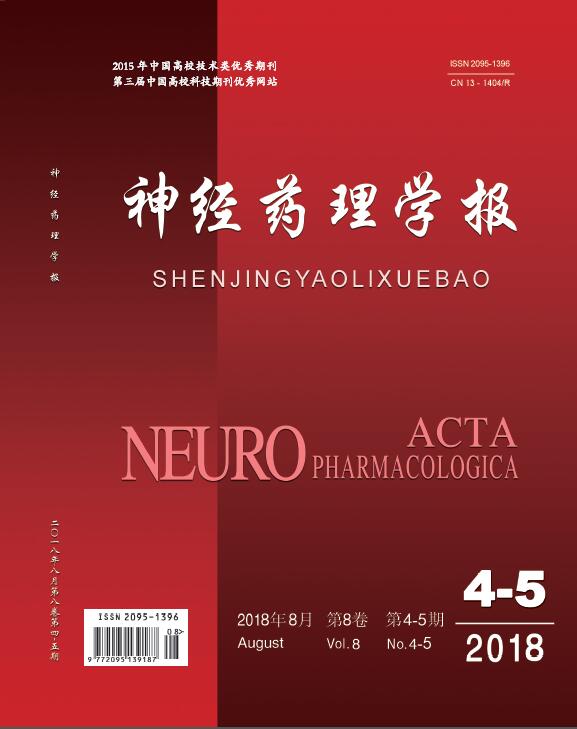|
|
Effect of Fasudil on Remyelination Following the Cuprizone-Induced Demyelination in Male C57BL/6 Mice
WANG Jing1,3,SUI Ruo-xuan2,MIAO Qiang2,WANG Qing2,SONG Li-juan2,YU Jie-zhong1,LI Yan-hua1,XIAO
2018, 8 (5):
74-76.
Background Multiple sclerosis (MS) is an autoimmune, inflammatory demyelinating disease of the central nervous system (CNS) characterized by de-/ remyelination, neuroinflammation and oligodendrocyte loss. Although a greater understanding of MS have increased acquaintance of the pathogenesis and pathophysiology, the exploration of treatment is still challenging. Fasudil, one of the most thoroughly studied Rho kinase (ROCK) inhibitors, has been shown to have effects in neurodegenerative diseases. However, the effect of Fasudil on preventing the progression of the demyelination in MS has not been evaluated. Cuprizone (CPZ)-induced demyelination is a model used to study de-/ remyelination in the CNS. Some aspects of the histological pattern induced by CPZ are similar to MS. The aim of the study is to investigate the effect of Fasudil on CPZ-induced demyelination, and to explore the mechanisms for the possible remyelination. Materials and Methods Male C57BL/6 mice (10–12 weeks old) were assigned into normal group, fed a normal diet; CPZ group, fed CPZ and intraperitoneally (i.p.) injected with normal saline after 4 weeks for consecutive 2 weeks; Fasudil-treated CPZ group, which were i.p. injected with Fasudil (40 mg/kg/day) after 4 weeks for consecutive 2 weeks. All groups were assessed by Elevated plus-maze (EPM) test and Pole test at the end of the experiment. For examing the extent of demyelination, Luxol Fast Blue (LFB) staining, Black Gold II and myelin basic protein (MBP) immunohistochemistry staining were used for slides of brains. Splenic MNCs were fixed and stained with the following antibodies: Alexa Fluor B220, FITC-CD4/PE-IFN-γ, FITC-CD4/PE-IL-17. At least 10, 000 events were collected using flow cytometer. Results Following CPZ-exposure, mice presented a lower density of LFB, Black Gold II and MBP expression, loss of mature oligodendrocytes. Spleen atrophy was observed in CPZ-group compared to normal mice, and we firstly found that CPZ feeding induced the formation of MOG antibody. Fasudil treatment improved behavioral abnormality, promoted remyelination, inhibited spleen atrophy and production of MOG antibodies, prevented the infiltration of peripheral T cells, B cells, macrophages, and declined the neuroinflammation by inhibiting Iba1+iNOS+, Iba1+NF-κB+ microglia. Fasudil treatment also reduced the levels of IL-1β, IL-6 and TNF-α. Discussion In this study, we demonstrated that demyelinating model was successfully established. Then we tested whether Fasudil plays a remyelinating role in this model. Spleen atrophy was observed after CPZ-feeding compared to normal mice. Previous studies have shown that splenic atrophy in experimental stroke may contribute to brain injury possibly through the release of inflammatory mediators and spleen-derived inflammatory cells to the circulation and migration into the brain, which aggravate the brain inflammatory response and led to secondary injure. At present, we lack direct evidence to elucidate the mechanisms for spleen atrophy in CPZ-induced demyelination. We firstly found that CPZ-feeding induced the formation of MOG antibody. Recent study indicated that BBB hyperpermeability precedes demyelination in CPZ-demyelinating model. Another study suggested that debris of damaged cells in the CNS may present as antigens after penetrating the BBB, giving rise to autoantibodies. Therefore, it is possible that the myelin debris produced the destruction of myelin sheath can enter the blood circulation and stimulate the immune response of T and B cells. We found that MOG antibody was elevated in the supernatant of cultured plenocytes, indicating that the MOG antibodies were derived from peripheral immune cells. Our results showed that the level of MOG antibody in the brain homogenate of CPZ-treated mice was higher than that of normal mice, suggesting that antibodies can enter brain tissue and anti a-synuclein antibody was negative, which indicate that anti MOG antibody is a specific antibody. In our study, MOG antibody was capable of being detected in the brain of CPZ-treated mice, providing a possibility for specific MOG antibody-mediated oligodendrocyte damage. CPZ induced a wide range of Iba-1+ microglia, which was inhibited by Fasudil. These results suggest that the suppression of inflammatory microenvironment may contribute to the remyelination. In conclusion, the administration of Fasudil promoted remyelination by multiple mechanisms.
Related Articles |
Metrics
|

